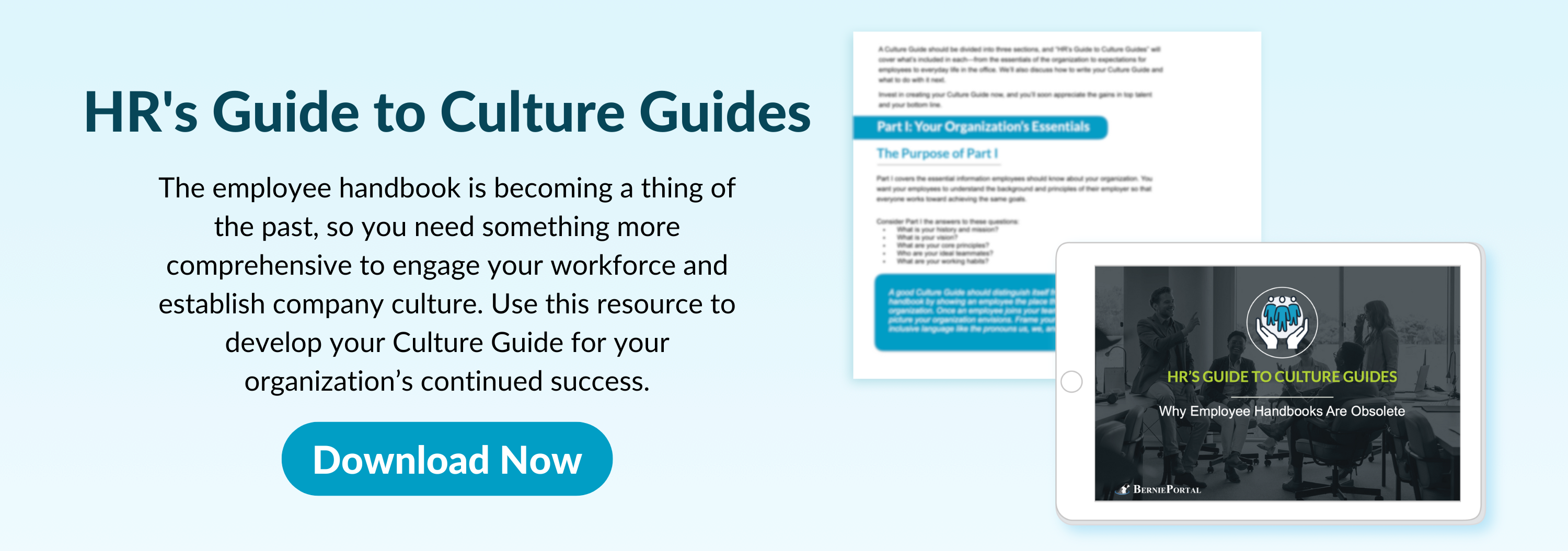Written by
Bretton Chatham
Bretton is an aPHR-certified member of the Marketing Team at Bernard Health. He writes about HR, compliance, and benefits solutions.
Culture Guides: What They Are and Why You Need One
.jpg)
Your employee handbook probably isn’t working for you. While the idea behind them is good, most of them are bad in practice because, too often, they focus only on keeping the organization compliant in the year the handbook was written. In the modern workplace, however, employees are not motivated by what their employer needs to do to merely remain compliant.
Instead, workers need to understand why their work matters and how it’s making an impact on the world. This is beyond the scope of even the best employee handbooks…which is why your organization needs something better: a Culture Guide.
In this article, we’ll cover the basics of culture guides: what they are and what to include. For a deeper dive, download your free copy of HR’s Guide to Culture Guides today. This ebook includes step-by-step instructions for writing your own and next steps for how to use it.
What is a Culture Guide?
A Culture Guide covers the compliance and procedural concerns of the typical employee handbook, but it goes much deeper than that—into the history of an organization, its vision, norms, and even how to leave the organization with grace.
It can give your workforce the key to a healthy company culture—a sense of shared purpose and belonging. It can even help new hires connect to the printer.
A Culture Guide should be divided into three parts:
- Part I: Essentials
- Part II: Expectations
- Part III: Everyday
What Should Be Included in Part I of a Culture Guide?
Part I covers the essentials of your organization. It can be helpful to think of Part I as answering the most important and most basic questions about your organization. Since this section focuses on the essentials, it is unlikely to ever change.
Part I is the section that most distinguishes a Culture Guide from an employee handbook. If it’s written well, it should also highlight what distinguishes your organization from your competitors.
- History and Mission (When and What?)
Naturally enough, start at the very beginning with your organization’s history. Tell the story of when the organization was founded—including a few early milestones and anecdotes—and what its mission is. Also, be sure to share some early struggles or challenges.
- Vision (Where?)
Once you’ve established where the organization has been and what its mission is, now turn your attention to where the organization wants to go. Like a person, an organization's identity is formed not only by your past, but also by your hopes for the future.
- Core Principles (Why?)
If your vision statement addresses your “Where?,” then the next section digs into your “Why?” Your core principles are the values that guide and motivate your team’s actions to be successful every day.
- Ideal Teammates (Who?)
Next, consider who you want to join you in this meaningful work. Describe the ideal teammate, outlining what you expect from employees in light of your vision and core principles.
- Working Habits (How?)
This section should focus on how teammates should work, including:
—Your organization’s work style
—How to conduct sales efforts
—How to share feedback with one another
—How to solve problems
—How to conduct meetings
—How to write emails
What Should Be Included in Part II of a Culture Guide?
Part II covers the expectations of your organization. Since Part II focuses on employee expectations, it may evolve over time.
Although Part II may change as you add new products/services or update to industry trends, there should be a throughline connecting Part II’s expectations to Part I’s essentials. Similarly, Part II deals directly with many factors affecting company culture.
- Structure
This section should outline your organizational structure and expectations. List your organization’s brands and the different teams that fall under each. Address employee titles, email signatures, and business cards for consistency across the organization.
- Communication Norms
You should document expectations for how teammates interact with one another across different communication channels. Explain what the preferred method of communication is for particular circumstances.
- Compensation Practices
Compensation transparency helps your organization build culture, stay consistent, and save time by setting expectations for how roles are compensated and how raises are awarded. Include how salaries are calculated, how paid time off policies work, and how remote work requests will be handled. Be sure to address how compensation and benefits policies differ between exempt and non-exempt teammates.
- Technology Needs
You should answer questions like:
—Do different roles get different hardware technology?
—What about software?
—What tools can employees expect to receive or purchase?
—What tools are employees expected to provide?
Writing this down avoids having to deal with a lot of one-off requests and further fosters an environment of fairness and consistency.
- How to Leave the Organization
Employee turnover is a part of life for all employers, and how workers leave is vital to this process. Address what’s expected of teammates who are moving on, including how to share the news with their manager and how much notice they should give. If you want employees to leave with grace, you must show them what that looks like.
What Should Be Included in Part III of a Culture Guide?
Whereas Parts I and II may be 10 pages total, Part III will likely be much longer, covering the everyday details of your organization. Part III deals with the nitty gritty of the daily grind, so it should be subject to change as needed. Part III is the section that most resembles a typical employee handbook, documenting organization policies, housekeeping issues, and compliance procedures.
In fact, much of Part III can probably come from your current employee handbook. Use this opportunity to make sure what you have is up-to-date. Here’s a checklist of what to include—which is basically whatever employees need to know to be successful in day-to-day operations:
- Contact List and Common Abbreviations Defined
- Compensation and Benefits
- Paycheck Deductions
- Compensation Changes
- PTO Policy
- Sick Leave
- HSA Contributions
- 401(k)
- Parental Leave
- How to View Paychecks
- Business Expenses
- Anti-Discrimination Policy
- Data Security Policy
- Social Media Guidelines
- Logistics
- Fax
- Phone
- How to Connect to the Printer
- How to Host a Webinar
- Ordering Office Supplies
- Processing Payments
- Tech Skills and Tech Support
- Specifics to Your Industry, such as licensing, certification, etc.
Additional Resources
For more information, download your free copy of HR’s Guide to Culture Guides today. This ebook includes step-by-step instructions for writing your own and next steps for how to use it.
You can also stay informed, educated, and up-to-date with important HR topics using BerniePortal’s comprehensive resources:
- BerniePortal Blog—a one-stop-shop for HR industry news
- HR Glossary—featuring the most common HR terms, acronyms, and compliance
- HR Guides—essential pillars, covering an extensive list of comprehensive HR topics
- BernieU—free online HR courses, approved for SHRM and HRCI recertification credit
- HR Party of One—our popular YouTube series and podcast, covering emerging HR trends and enduring HR topics
Written by
Bretton Chatham
Bretton is an aPHR-certified member of the Marketing Team at Bernard Health. He writes about HR, compliance, and benefits solutions.
Related Posts
Part-time work is becoming increasingly common in today’s workforce—especially for...
As you know, healthcare and benefits can be complicated, which can make the enrollment...
With the deadline for filing and distributing 1095-C forms approaching, staying...
A strong paid time off (PTO) policy helps retain current talent and attract prospective...







Submit a Comment